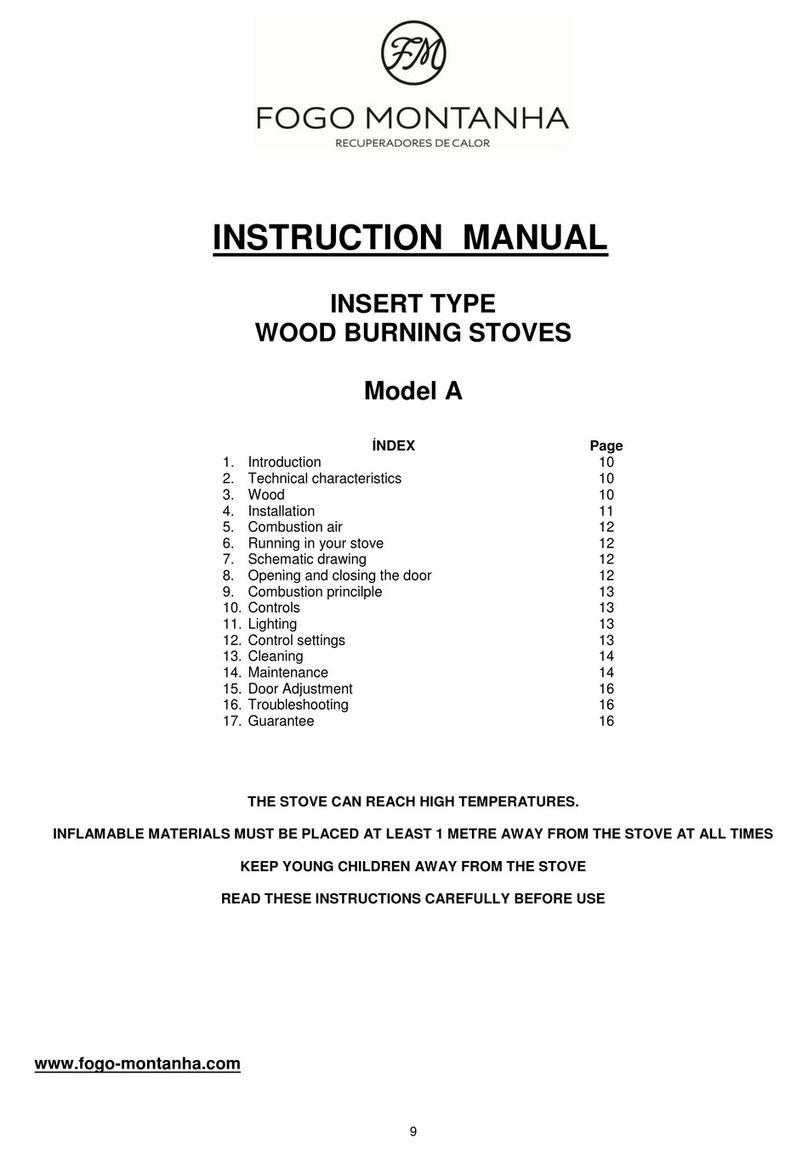8. OPENING AND CLOSING THE DOOR
Place the handle supplied into the hole provided in the door catch (D). Pull handle towards you to open the door and push
away from you to close the door. The stove surfaces can become very hot. Use temperature resistant gloves at all times.
9. COMBUSTION PRINCIPLE
The stove is designed so that full of wood, with a slow flame, it will burn at maximum efficiency for several hours. The
stove can be made to burn overnight, very slowly, with little or no flame. This is not advisable because this incomplete
combustion creates extra smoke, which, upon condensation, deposits tar on the stove, chimney and glass panel. An
accumulation of such tar deposits is not only unsightly but also requires regular chimney cleaning to prevent chimney
fires. If you are burning wet or green wood then the Combustion Air Control should be left open enough to ensure the
creation of a slow, gentle flame.
Radiant heat
This is given from the hot embers and stainless steel and vermiculite back panels. The radiant heat is transmitted through
the glass panel into the room and heats the immediate area in front of the stove.
Convection heat
Cool air enters via the cold air inlet, (A). It then passes along the base of the stove up the back and over the top before
being expelled from the primary hot air outlet, (B). This convection air reaches the farthest corners of the room. Its flow is
accelerated by means of a fan installed within the cold air inlet and at the back of the stove.
10. CONTROLS
Primary combustion air control (C)
This controls the amount of combustion air entering the stove thereby controlling the heat output. It’s also used for the
glass cleaning process: a process of high speed cleaning, using the pre heated air over the internal glass surface.
To open –Slide to the left for a bigger heat output and wood consumption
To close –Slide to the right for a smaller heat output and wood consumption
Secondary combustion air control (D)
It controls the quantity of combustion air entering the stove through the air channels locatedon the combustion chamber
rear. The air enters the combustion chamber through the channel increasing the combustion efficiency and reducing the
emissions.
To open –Slide to the left
To close - Slide to the right
Fan control switch (F)
The switch has three settings:
I ON –Thermostatically controlled (low fan speed). The fan is turned on/off automatically depending on the stove and
fan temperature.
O OFF –Fan Off
II ON –Manual control –high speed fan
When firing up the stove,
When firing up the stove from cold switch the fan to II “ON” - high speed, to heat the room as quickly as possible and to
force combustion air into the stove. Once the room has reached desired temperature switch to I“ON” - thermostat
control. The fan will then connect and disconnect subject to the temperature of the fan and of the stove. If you want to
switch the fan off completely, then switch to the OFF position « 0 ».
Note: The thermostat is a means of controlling the temperature of the fan and not a room temperature control.
11. LIGHTING
The highest output is achieved by means of "top-down" burning. To achieve this, do not fill the stove in the traditional way.
Traditional way: what is meant here is laying down paper first, then kindling and finally large logs. With this method the
load is limited when lighting the fire.
"Top-down" burning: this is done by loading the large logs first, then the smaller pieces, and the paper on top. In this
case combustion takes place from the top down and is known as "Top-down" burning.
From cold
1. Fully open combustion air control.
2. Open door.
3. Place the large logs carefully on the bottom.
4. Cover it with smaller logs, and on top of this lay firelighters or paper and finally kindling.
5. Light the fire, close the door and set the ventilator to position 1.
6. Leave the combustion air inlet fully open until the wood is burning and the ashes glow.
7. Choose a control setting.
Reloading
1. Fully open combustion air control.
2. Open door.
3. Using poker provided rake hot embers evenly around the vermiculite base.































